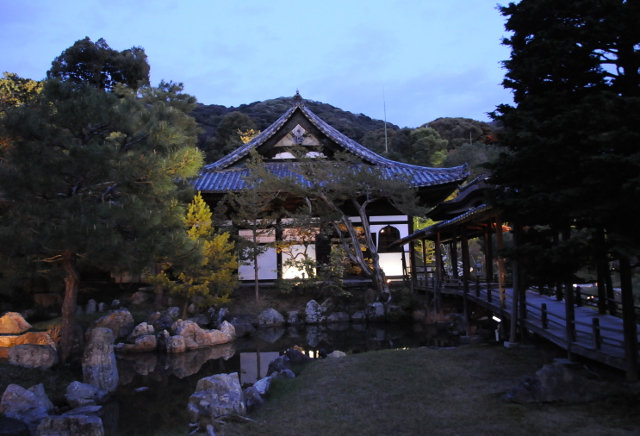Every year in August, Kodai-ji Temple holds a special Cool Night Yukata Tea Ceremony in the weekends and this year, I convinced a friend of mine to go together with me.
Of course, we both had to wear Yukata for the occasion, mainly because it is nice, but also because we wanted to get the 500 yen discount that was offered for people wearing yukata. Of course, if you’re wearing traditional Japanese clothing at a traditional Japanese event, you need to go all the way: When making the reservation, we were informed that we needed to wear tabi, white Japanese socks with separate big toe. This is actually standard since it is rude to enter a room (in particular one with tatami) barefoot.
So, one day before the tea ceremony, I went to a special tabi shop on Sanjo dori to buy me some traditional footwear. And: I failed. Problem is that tabi are made of relatively stiff cotton that is not flexible at all, so they are closed at the inside of the ankle with some sort of buttons, for lack of a better word. And, while my feet are the rather standard Japanese size of 24.5 cm, my ankles are not…
Anyway, the next day in the evening I showed up at my friend’s place with the yukata she gave to me a few years back, a whole pile of assorted accessories including obi and geta and a pair of white socks to put on at the tea ceremony proper. I had hoped that my friend would be able to help me putting on the obi – which alone takes me 30 minutes every time – but it turned out that she hasn’t got a clue how to do this since she only wears a very simplified version that doesn’t require wrapping a piece of cloth the length of an anaconda around your waist… At least she could hold some of the pieces in place while I squirmed into them, her extra pair of hands did help.
 When we arrived at Kodai-ji, it turned out to be a very small tea ceremony with only seven people in total. The setting was less formal that I had expected (and dressed for), we were sitting on little chairs on a low table instead of kneeling on the floor in seiza. The room was beautifully decorated according to the theme – glass – and all the tea utensils down to the tea scoop were made from glass (except the tea kettle, of course).
When we arrived at Kodai-ji, it turned out to be a very small tea ceremony with only seven people in total. The setting was less formal that I had expected (and dressed for), we were sitting on little chairs on a low table instead of kneeling on the floor in seiza. The room was beautifully decorated according to the theme – glass – and all the tea utensils down to the tea scoop were made from glass (except the tea kettle, of course).
Since I had been at tea ceremonies before, I roughly knew what to do – there’s a lot of bowing involved – but once again, I completely missed the preparation of the tea. In tea ceremonies for larger groups, the main host is entertaining the guests by smalltalk or explaining the tea utensils or the art used in the tokonoma. Meanwhile, another person actually makes the tea for the top one or two guests, and all the other guests get their tea served from behind the scenes.
I found the sweets that were offered before the matcha a bit tasteless, but they looked like a heart placed behind glass to fit the theme. What I really like about tea ceremonies is that afterwards, you are invited to inspect the room and check out all the tea bowls and other utensils and the tokonoma as well. Sadly, I didn’t expect that it was allowed to take photos at that time, so I didn’t bring my camera…
Oh well. In any case I had fun and spent a nice evening at the temple, although it was very hot outside even after the sun went down. The yukata didn’t help with that either. One thing I still have to figure out is how my Japanese friend can look all cool and poised and relaxed at a hot night like this while I look like I’ve just emerged out of a steam bath and getting ready to burst into flame… I shall investigate.
